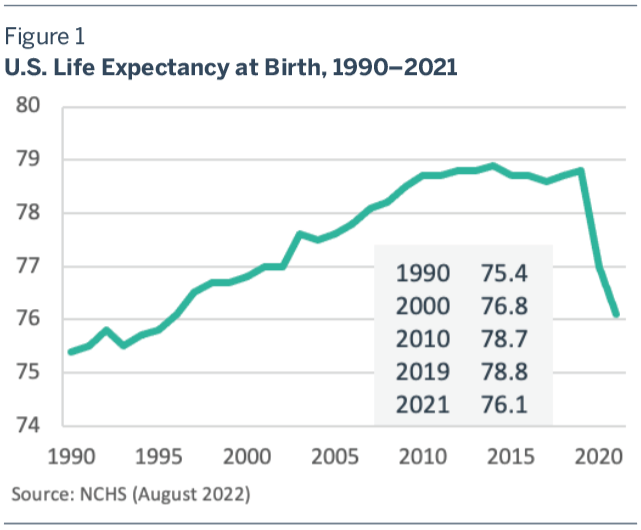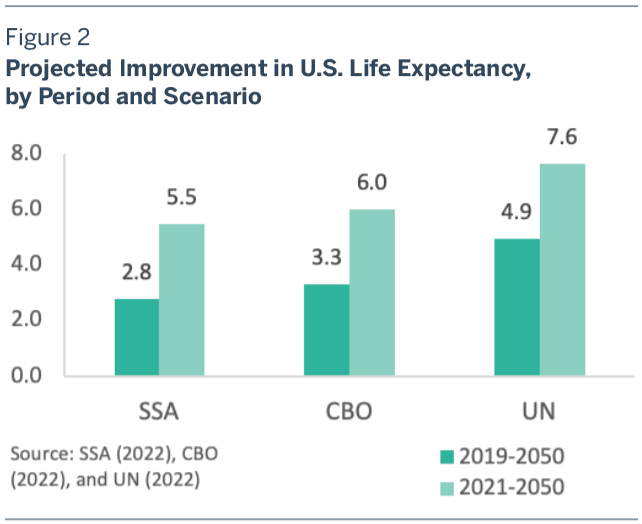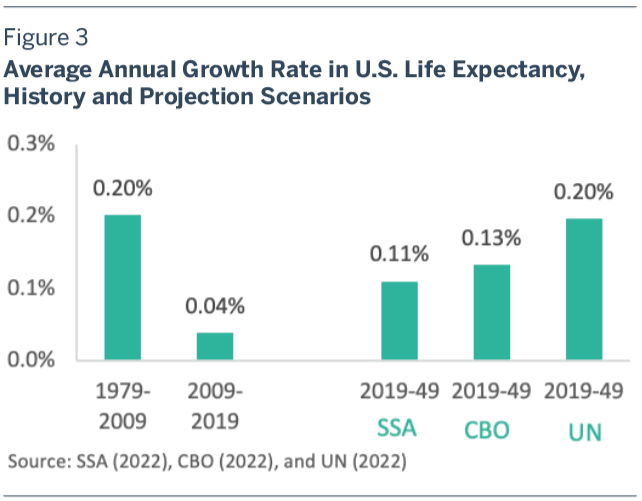More Grim News on U.S. Life Expectancy
Vantage Point: Mini Briefs from The Terry Group and the Global Aging Institute
September 19, 2022

U.S. life expectancy has been much in the news lately, and the news has been mostly grim. In this Vantage Point, we review recent developments on the life expectancy front. We also consider the disconnect between the increasingly uncertain prospects for U.S. life expectancy and the optimism of most projections.
U.S. life expectancy has been much in the news lately, and the news has been mostly grim. The recent CDC report showing that life expectancy fell for the second straight year in 2021 was the most widely covered development. But there have also been new and worrisome reports on the large and growing gap in life expectancy between the United States and its developed world peers, as well as on the enormous variation in life expectancy across America’s fifty states.
In this Vantage Point, we review recent developments on the life expectancy front. We also consider the disconnect between the increasingly uncertain prospects for U.S. life expectancy and the optimism of most projections, which continue to assume that it will rise steadily in decades to come.
Another Annus Horribilis
U.S. life expectancy plunged by 1.8 years in 2020 as COVID-19 swept the nation. According to a report released by the CDC’s National Center for Health Statistics in late August, it fell by another 0.9 years in 2021.1 Even the smaller 2021 decline ranks as the second largest single year drop since World War II. Coming on top of the 2020 decline, it has dragged down U.S. life expectancy to 76.1, no more than it was in 1996 a quarter of a century ago. (See figure 1.) When it comes to life expectancy, 2021 was another annus horribilis.
It is true that all of these numbers are period measures, and as such may overstate the long-term impact of COVID-19 on life expectancy. In calculating period life expectancy, demographers and actuaries assume that the mortality rates observed at each age in the current year will remain unchanged in all future years. Period life expectancy is a useful construct, and generally tracks the long-term trend in cohort life expectancy fairly well. However, it can diverge from that trend when unusual mortality events like COVID-19 occur. Think about it: When the CDC calculates that life expectancy in 2021 was 76.1, it is assuming that Americans five, twenty-five, or fifty years from now will still be dying from COVID-19 at the same rate they did in 2021. Needless to say, this is unlikely to be the case. COVID-related mortality will almost certainly decline over time, and as it does life expectancy should rise again.
That said, anyone expecting a quick and complete rebound may be disappointed. New and more deadly COVID variants may emerge, a significant share of the population remains unvaccinated, and the ultimate mortality impact of long COVID remains unknown. COVID-19, moreover, is not the only development that drove up mortality rates in 2020 and 2021. Unintentional deaths, largely due to drug overdoses, also surged. Then there is the fact that many Americans postponed tests and treatments for other medical conditions during the pandemic, which could elevate mortality rates for everything from cancer to cardiovascular disease for years to come.
From Leader to Laggard
Whatever happens with COVID-19, there is a deeper problem. While the pandemic-related plunge in U.S. life expectancy has grabbed the headlines, the pace of improvement in life expectancy had already slowed long before the pandemic hit. In fact, U.S. life expectancy failed to rise at all in the decade prior to the pandemic, the first ten-year period in which this happened since the federal government began keeping comprehensive mortality statistics in 1900. As we explained in “From Longevity Leader to Longevity Laggard” (Critical Issues no. 2, June 29, 2021), the main cause of the slowdown is the increase in lifestyle-related morbidity and mortality among young and midlife adults, which in turn is largely the result of the increase in rates of obesity and substance abuse.
Americans once enjoyed one of the highest life expectancies in the world. But as improvements in life expectancy slowed, then stalled, its relative advantage has steadily eroded.2 Back in 1950, there were only eleven countries in the world with a greater life expectancy than the United States, and only five of them, all in Northern Europe, had a life expectancy exceeding ours by two years or more. By 2019, on the eve of the pandemic, there were forty countries, and twelve of them had a life expectancy exceeding ours by four years or more. Among fully developed economies, America now ranks dead last.
The pandemic has further eroded America’s relative standing. Life expectancy of course fell in most developed countries in 2020, but on average it fell much less than in the United States. In 2021, moreover, life expectancy began to rise again in many other developed countries, even as it continued to decline here. According to one recent study that compares the United States with a group of twenty-one other rich countries, the gap in life expectancy between America and its “peers” widened from 3.4 to 5.5 years between 2019 and 2021.3
Less Than in Bangladesh
With life expectancy, as with most things, averages rarely tell the whole story. It is by now well documented that morbidity and mortality in America are increasingly skewed by income and educational attainment. At least until the pandemic struck, life expectancy was still rising, albeit slowly, for those Americans who are more affluent and better educated, while it was falling for those who are not.
Given the differences in income and educational attainment across the fifty states, it is hardly surprising that there are also differences in life expectancy. What is surprising is how large the differences are. According to another recent CDC report, also released in late August, life expectancy in 2020 ranged from a low of 71.9 in Mississippi to a high of 80.7 in Hawaii.4 The gap between the state with the lowest life expectancy and the state with the highest is thus nearly twice as large as the gap between U.S. average life expectancy and the average for America’s developed world peers. Incredibly, life expectancy in fourteen states in 2020 was less than life expectancy in Argentina, while life expectancy in nine states was less than life expectancy in Iran. In one state, Mississippi, it was less than life expectancy in Bangladesh.
The relative standing of the fifty states has changed little in recent decades, suggesting that the factors which tend to drag down life expectancy in some states are deeply entrenched. No state that had a below-average life expectancy twenty years ago now has an above-average one. And only one state that ranked in the bottom twenty states twenty years ago now ranks in the top twenty: Virginia.5
Judgement Calls
Despite America’s recent dismal record on life expectancy, the Social Security Administration’s Office of the Actuary (SSA), the Congressional Budget Office (CBO), and the United Nations Population Division (UN) all assume in their most recent projections that life expectancy will not only bounce back to where it was two years ago, but will also rise substantially above its pre-pandemic level in coming decades. By 2050, the SSA projects that U.S. life expectancy will be 2.8 years higher than it was in 2019, the CBO projects that it will be 3.3 years higher, and the UN projects that it will be 4.9 years higher. (See figure 2.)
In setting projection assumptions, it is necessary to make judgement calls about whether departures from long-term trends are merely temporary deviations or represent new long-term trends. The SSA, CBO, and UN apparently believe that the recent slowdown in U.S. life expectancy is a temporary deviation, and so assume that the rate of improvement in life expectancy will again accelerate to something closer to (or in the case of the UN, equal to) its longer-term pre-2010s trend. (See figure 3.)
Only time will tell whether this optimism is justified. In our view, however, it would be a mistake to take a turnaround for granted. The health of younger cohorts of Americans has been deteriorating, both relative to older cohorts of Americans and to younger cohorts in other developed countries. Putting life expectancy back on an upward trajectory may require a major, multi-year educational campaign, as well as massive new investments in health and health equity. Too much is at stake to leave it to chance.




 Issue Brief: From Longevity Leader to Longevity Laggard
Issue Brief: From Longevity Leader to Longevity Laggard